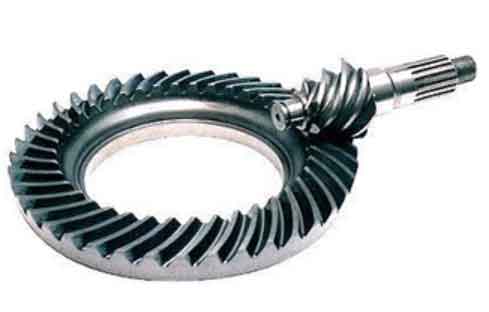Hypoid gears are a type of gear where the axis of the two shafts intersects at a point but not in the same plane, creating a spiral angle. This configuration differs significantly from more common gear types, like spur or helical gears, where the shafts are parallel or intersecting in the same plane. Let’s delve into the design, applications, and advantages of hypoid gears.

Design
Hypoid gears are designed with a hypoid pinion and a hypoid gear. The pinion is typically smaller and is mounted below the larger gear. This setup allows the pinion to engage the gear at an angle, creating a cone-shaped contact area. The teeth on hypoid gears are helical, and their design requires precise calculations to ensure that the gears mesh correctly without causing undue stress or wear on the teeth. The design allows for smooth and continuous contact between the teeth, resulting in a more efficient transmission of power.
Applications
Hypoid gears are commonly used in applications where a large speed reduction is needed between two perpendicular shafts in a compact space. Their most notable application is in the automotive industry, specifically in the differential of rear-wheel-drive vehicles. Here, they enable the transmission of power from the driveshaft to the vehicle’s axle at a right angle, which is crucial for turning the wheels while allowing them to rotate at different speeds. Beyond automotive applications, hypoid gears are also found in some heavy machinery and industrial equipment where space constraints and the need for large torque transmission are present.
Advantages
The design and application of hypoid gears bring several advantages:
- High Efficiency: Despite the spiral angle, hypoid gears maintain high efficiency, making them suitable for high-speed, high-torque applications.
- Smooth Operation: The gradual engagement of the gear teeth allows for smoother operation, less noise, and reduced vibration compared to other gear types, such as bevel gears.
- Increased Strength: The larger contact ratio (the average number of teeth in contact during rotation) enhances the strength and load capacity of hypoid gears.
- Compact Size: The ability to transmit motion and power between non-parallel, non-intersecting shafts allows for more compact gear arrangements.
- Versatility: Hypoid gears can handle a wide range of velocities and loads, making them versatile for various applications.
However, the advantages of hypoid gears come with the trade-off of increased complexity in design, manufacturing, and maintenance. They require precise alignment and lubrication to operate efficiently and to avoid premature wear. The oil must be capable of withstanding high pressures and temperatures due to the sliding contact of the gear teeth.
In summary, hypoid gears are a critical component in many mechanical systems where space is limited, and large torque transmission is required. Their design allows for efficient, quiet, and smooth operation in a compact form factor, making them an ideal choice for many high-performance applications, especially in the automotive industry.
